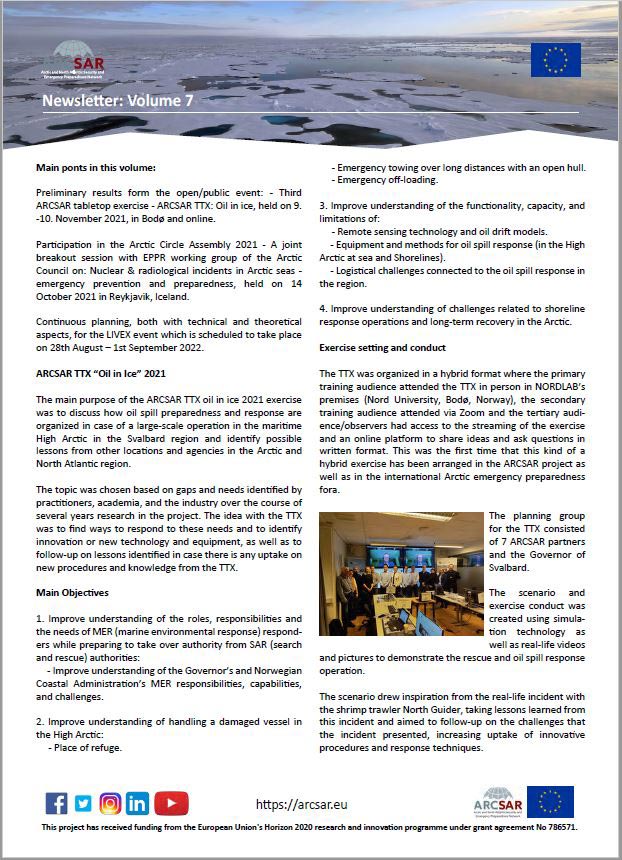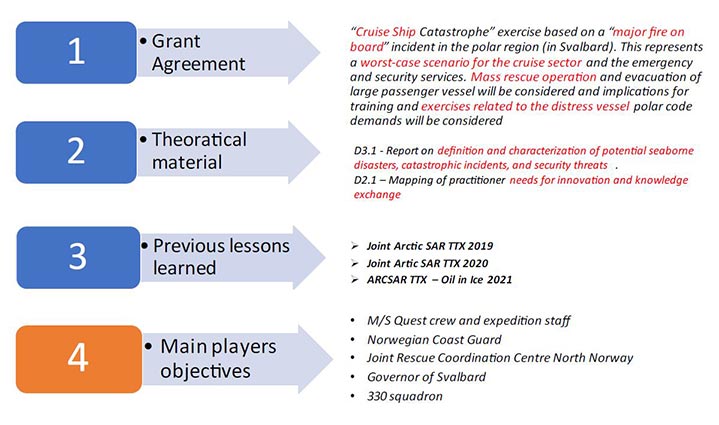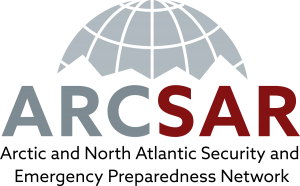ARCSAR – Newsletter V.7

Main points in this issue:
- Preliminary results from the Third ARCSAR tabletop exercise – ARCSAR TTX: Oil in ice held on 9. -10. November 2021, in Bodø, Norway (Hybrid format).
- Participation in the Arctic Circle Assembly 2021 – A joint breakout session with EPPR working group of the Arctic Council on: Nuclear & Radiological Incidents in Arctic Seas – emergency prevention and preparedness held on 14 October 2021 in Reykjavik, Iceland.
- Continuous planning, both with technical and theoretical aspects, for the LIVEX event which is scheduled to take place on 28th August – 1st September 2022, in Longyearbyen, Svalbard.
ARCSAR TTX “Oil in Ice” 2021
The main purpose of the ARCSAR TTX oil in ice 2021 exercise was to discuss how oil spill preparedness and response are organized in case of a large-scale operation in the maritime High Arctic in the Svalbard region and identify possible lessons from other locations and agencies in the Arctic and North Atlantic region.
The topic was chosen based on gaps and needs identified by practitioners, academia, and the industry over the course of several years research in the project. The idea with the TTX was to find ways to respond to these needs and to identify innovation or new technology and equipment, as well as to follow-up on lessons identified in case there is any uptake on new procedures and knowledge from the TTX.
Main Objectives
- Improve understanding of the roles, responsibilities and the needs of MER (marine environmental response) responders while preparing to take over authority from SAR (search and rescue) authorities.
• Improve understanding of the Governor’s and Norwegian Coastal Administration’s MER responsibilities, capabilities, and challenges. - Improve understanding of handling a damaged vessel in the High Arctic.
• Place of refuge.
• Emergency towing over long distances with an open hull.
• Emergency off-loading. - Improve understanding of the functionality, capacity, and limitations of:
• Remote sensing technology and oil drift models.
• Equipment and methods for oil spill response (in the High Arctic at sea and Shorelines).
• Logistical challenges connected to the oil spill response in the region. - Improve understanding of challenges related to shoreline response operations and long-term recovery in the Arctic.
Exercise setting and conduct
The TTX was organized in a hybrid format where the primary training audience attended the TTX in person in NORDLAB’s premises (Nord University, Bodø, Norway), the secondary training audience attended via Zoom and the tertiary audience/observers had access to the streaming of the exercise and an online platform to share ideas and ask questions in written format. This was the first time that this kind of a hybrid exercise has been arranged in the ARCSAR project as well as in the international Arctic emergency preparedness fora.

The planning group for the TTX consisted of 7 ARCSAR partners and the Governor of Svalbard.
The scenario and exercise conduct was created using simulation technology as well as real-life videos and pictures to demonstrate the rescue and oil spill response operation.
The scenario drew inspiration from the real-life incident with the shrimp trawler North Guider, taking lessons learned from this incident and aimed to follow-up on the challenges that the incident presented, increasing uptake of innovative procedures and response techniques.
Extensive preparation was done before the exercise to make sure that the participants and different training audiences were aware of their roles in the exercise and had enough background material to comment and participate actively. The moderators were also prepared with questions and topics to prompt the training audiences to discuss issues related to the scenario.
The TTX was moderated by the Norwegian Coastal Administration for the primary audience and the Canadian Coast Guard (ARCSAR associated partner and EPPR/Arctic Council liaison on oil spill response) for the secondary training audience. 31 organizations from 14 different countries participated in the event. Many of them were both partners from the ARCSAR consortium and associated partners/external stakeholders in the ARCSAR network.
Preliminary results from the exercise:
In the newsletter listed you will find three learning outcomes from each of the themes. However, for a full list of learning outcomes, we encourage to read the upcoming exercise report.
Theme 1: Improve understanding of the roles, responsibilities and the needs of MER responders while preparing to take over authority from SAR authorities
“The exercise demonstrated that early and continuous information sharing between SAR and MER authorities and that they uphold a common understanding of needs and availability of resources is absolutely necessary to ensure an effective response. “
“It is challenging considering the possible lack of resources that is capable to operate in an arctic climate. This Includes the maritime resources, but also all the logistics that come with such an operation. The initial assessments is very important and the necessary measures must be taken already during the SAR phase. Furthermore, it is important to have in mind that a transfer of responsibility does not take place suddenly, but that it is a seamless transfer from JRCC to the Norwegian Coastal Administration. “
“The main learning point is that exercises like this is of great value. To have representatives from all stakeholders present in the same room gives an excellent opportunity to address complex challenges. “
Theme 2: Improve understanding of handling a damaged vessel in the High Arctic
“Regarding the point that the crew on board the distress vessel should, if at all possible, prepare the vessel for emergency towing before being evacuated, participants felt that it was a good reminder and proposed that this should be taken as a best practice for the future.”
“Participants also saw that in this kind of environment, it may not always be the best option to tow a vessel to a location that may cause more environmental damage than if it is left in the open sea.”
“Another suggestion from the participants was that such operations in the High Arctic at this time of the year are very challenging due to ice and darkness. The health and safety for the responders will be very important, but there is also a risk that vessels with limited ice class might be stuck in the ice with subsequent danger.”
Theme 3: Improve understanding of the functionality, capacity, and limitations of remote sensing technology and oil drift models, equipment and methods for oil spill response (in the High Arctic at sea and Shorelines) and logistical challenges connected to the oil spill response in the region.
“The participants concluded that in this regard there is a continuous need to advance technology and learn from R&D and academic institutions about what research is ongoing in this regard. This idea has now been taken into consideration with the Arctic Council’s EPPR working group, and they have established a project for sharing R&D news.”
“It is also important to understand what is required to do the job as conditions may be extremely harsh and can have different types of oil reacting in different ways, requiring containment and extraction from different types of equipment. Therefore, careful consideration needs to be given as to what equipment is carried on board vessels (both from authorities but also vessels of opportunity). The equipment able to be used will depend on environmental / weather conditions at incident site, for example ice present or ice free. Mobilizing 2-3 times as much assets as normally needed was suggested as best practice regarding response in the Arctic.“
“There was also an agreement that the SAT lessons from the ARCSAR partner e-Geos was very good, also the available data tools from EPPR website were useful, increasing the uptake of innovations and new tools.”
“It was suggested that dropping AIS buoys into the oil to monitor and see where the oil drifts, should be established as best practice.”
Theme 4. Improve understanding of challenges related to shoreline response operations and long-term recovery in the Arctic.
“When it comes to the recovery in the case of an oil spill, there appear to be challenges that are brought forth by the environment i.e. ice conditions. There is a belief that once the oil has drifted to shore in an area like this, it is not possible to clean it up until summer.”
“It is very challenging based on available equipment. The most important part will be surveillance until the ice opens for better working conditions in the area. Personal safety always comes first, and there are few alternatives to secure the wildlife. As a suggestion on protecting wildlife, a Canadian participant suggested to consider protecting some vulnerable areas or islands with booms or patrolling. And this prompted more discussion on the challenges but also opportunities to do that. The exercise also discussed possible heating facilities/containers for equipment deployed to shore in order to ensure continuous operations for both people and machinery.”
“Cold temperatures and 24 hour darkness can severely limit response activities, or even reaching a remote location. Long term impacts to marine life and wildlife may be unavoidable, and cold temperatures extend recovery. For this reason, media strategy is important to be established early.”
Lessons identified and future training needs:
We mention here few of the interesting ideas that have come up during the exercise however for a full list of them we kindly advise to consult the full upcoming TTX report.
• When it comes to the takeover from SAR to MER, it would be good to consider ” take overs” that occur over a longer period and with overlap. SAR continues to stay alerted by MER activities as there is very strong possibility that they may be re-activated and required to rescue the MER responders given challenging conditions, remoteness etc. of the area.
• The pre-assessment and pre-designation of places of refuge (POR) mentioned by many participants was seen as very helpful and a way to save valuable time. The discussion on characteristics and assessment of POR was a good way to adjust the mindset to the complex problems that a MER operation poses.
• When it comes to the clean-up of oil, one size does not fit all! Deploying equipment that is not functional for one or other reason can be detrimental to the environmental cleanup effort due to delays in transporting suitable equipment to the spill site.
ARCSAR LIVEX 2022
Live major disaster exercise August 28th 2022 – September 1st 2022
The planning of the ARCSAR live exercise, bringing together key on-scene live exercising efforts, is well underway and has been ongoing during this 6-month period. ARCSAR partners and various stakeholders supporting safety in the Arctic have for the past six month put considerable work into meeting the grant agreement requirements, striving to make the event a success.

The ARCSAR live exercise represents an excellent way to achieve cooperation across practitioner groups, work together to highlight common capabilities and interfaces, and expose gaps, limitations, and obstacles.
Main exercise objectives:
1. Enhance the understanding of ARCSAR partners on factors that affect survivability and decision-making in the Polar region by exercising a live response to a simulated maritime incident.
2. Strengthen collaboration between the responding parties, including industry, and improve procedures for cooperation.

Joint breakout session with the EPPR/Arctic Council at the Arctic Circle 2021 event
As a part of WP5 dissemination tasks, ARCSAR organized a break-out session in cooperation with the EPPR working group of the Arctic Council during the Arctic Circle Assembly hosted in Iceland in 2021.
The session on “Nuclear & Radiological Incidents in the Arctic Seas – Emergency Prevention & Preparedness”, was chaired by Mr. Robert Lynch from Munster Technological University and had the chairperson of the EPPR, Kathy Nghiem, Dr. Natalia Andreassen from Nord University and Dr. Mikel D. Cainzos from the Joint Rescue Coordination Centre Norway as panelists.


The topic of the session stems from the findings presented in deliverables 2.1 and 3.1 and allowed connecting various stakeholders and projects such as RADEX (coordinated by the EPPR) and RNSARBOOK (coordinated by the JRCC Norway) and showcasing the work being done and uptake of innovative procedures in a sphere of SAR that has shown to have several shortcomings.
The session gathered around 50 people and generated a short debate on the topic where officials from EEC, students and SAR professionals voiced their concerns and shared ideas.
The session also served the purpose of providing a networking arena for future interorganizational and cross-sectoral work. One of the visible outcomes of the talks held during the panel is the Project ATOMEX (to be started in 2023) where various ARCSAR members as well as other actors will develop researched-based and technology driven exercises to enhance Maritime SAR operations in radiological and nuclear environments.
Download this newsletter (PDF)

